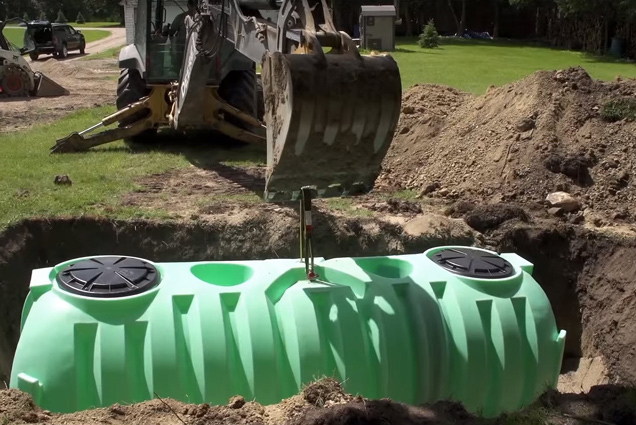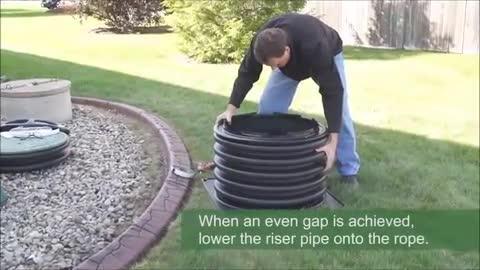Rural areas might be unable to access municipal sewage systems. You'll need a private water treatment plant to cleanse and dispose of your wastewater. This is the reason homeowners who live in rural areas or do not have access to municipal sewage systems must get one installed before they move. There are various kinds of home-septic tanks. They all accomplish the same thing. They remove waste from our homes, remove undesirable substances, and then discharge clean water to the waterways. The cost of a home septic tank will depend on its size and capacity. A larger model can be more efficient at reducing the number of chores that are required every day, since less liquid is created than a smaller one.
How Much Will A Septic System Run?
The traditional system of septic tanks has become obsolete and no longer works as it did in past. The United States can pay anywhere from $2,500 to $5K on a septic tank, without considering permits and the cost of plumbing your drain field. Aerobic and anaerobic septic systems types are what you should consider if cost isn't the main thing on your list of priorities. These new machines are called "septic systems" and they can be bought. They can be expensive at first, but they last long and require very little maintenance.
Aerobic systems require oxygen that accelerates decomposition and creates less sludge than alternatives. This waste can be used for irrigation purposes as long as there aren't any other sources. Anaerobic food items need less space since they consume about half the surface area of conventional systems. However, it comes at a steep price starting at 13000 dollars for 1000 gallons of water treated every year. Have a look at the top septic systems how they work for more.

How Much Does The Tank For Septic Tanks Cost?
The most cost-effective and lightweight alternative is polyethylene, also known as plastic septic tanks. The typical cost for one thousand gallon tank is about 1150 dollars, but their use can pose problems in the event of leaks under pressure in certain states in the US in which they've been banned because of damaged tanks, which can lead to costly repairs down the line , which could cost you money on installation price tag itself! Concrete septic tanks, a tried-and-true workhorse, will last for years without the need to be replaced. There have been instances when these tanks fail. However, cracks in these tanks are not usually serious. Fiberglass septic systems are an affordable option that homeowners can put in quickly and effortlessly. Fiberglass tanks are lighter than concrete or plastic tanks and can be difficult to set up in tight areas. This means less stress on your home and can result in greater construction quality overall.
What Does This All Mean For Me?
Knowing the elements that influence your septic tank's cost can be a daunting task. It is important to know the installation costs and their cost. NexGen Septics can help in making that decision. We offer detailed explanations on everything from permits to soil preparation costs to the cost of maintenance - all of which are a major factor in determining the total cost when installing new systems, as well. See the top how a drain field works for examples.

Septic System Types
The decision of which septic system to install is hard. The type you choose will affect the cost as well as the efficiency and whether it has enough room for it to be put in place. There are two widely used kinds:
1.) Anaerobic Septic System
The greatest benefit of a septic is the fact that it does not require electricity for operation. They rely on anaerobic bacteria which digest and destroy waste in the wastewater pipe of your home until there aren't food sources for them. Then they pull these away from other possible sources like household plumbing fixtures or even human excrement! The system is simple to set up and can cost between $2k and $5K based on what you need. It's not a lot of work and anyone who has completed any sort of maintenance at home should feel confident giving this installation.
2.) Aerobic Septic System
Aerobic Septic systems are comprised of aerobic bacteria that dissolves waste in septic tanks. To improve this process the use of a timer and motor are used together with effluent to ensure more efficient treatment of wastewater, while not letting it overflow into your lawn or crop similar to anaerobic tanks without proper installation techniques from companies like ours! These advanced types are approximately $13k to $26K and can be used annually for one tonne (less than half of what is needed by those who use traditional pit toilets).
Septic Tank Types
You can pick from concrete, gravel, or plastic septic tanks made of plastic, gravel, or concrete. The fiberglass-based tanks are incredibly light however, they can be utilized for long-term usage in harsh conditions like those on farms, where water is always moving around. Concrete is another option that's popular because of its weighty. It provides security to ensure that your home doesn’t topple when rainwater comes down with force. We also found these lightweight, but sturdy, polyester bags that you can get almost everywhere today. These are especially useful if your home is near an urban area because urbanization has brought us closer to each other than ever. See the most popular what goes into a septic tank for examples.

Plastic Septic Tanks
Although septic tanks can be great for managing your waste, it's important to make sure you get one that will last for. The lightest and most affordable type of septic tank available is polyethylene. But, they are likely to crack or break at some point. There's been advancements in plastics which make polyethylene toilets more durable than ever. But if the toilet isn't properly filled, they may be prohibited in California. Prices for 1000-gallon models differ according to where they are located.
Fiberglass Septic Tanks
Fiberglass septic tanks are lightweight and easy to install. They also have less algae growth than other types. They are also resistant to shrinking and expanding, which keeps fractures from forming inside the tank in the course of time. This is unlike porous materials like clay-based soil systems. Fiberglass prices will vary depending on how large you are, but they generally cost between $1600 and $2000 USD for 1000 gallons to 1500 gallons. The option of more capacity is available where the price jumps about 50%-100 percent.
Concrete Septic Tanks
Concrete septic tanks are durable and reliable, lasting at least 30 years when properly constructed. 1000 gallons will cost you $1200 while 1500 gallon models is approximately $1800. Concrete tanks can last between 15 and 20 years. But, depending on the maintenance habits, it could last even longer.